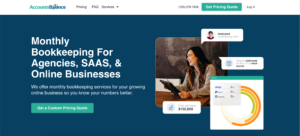
Looking to sell your SAAS business?
Congrats if it’s something you’re thinking about.
In this article, we’ll break down everything that you need to know about the acquisition process.
My name is Connor Gillivan. I’ve build multiple companies to 6, 7, and 8 figures with an exit in 2019.
I’ve been through the acquisition process and I’m excited to share everything you need to know about selling your SAAS business.
Here’s what we’ll cover:
- How Do You Value a SAAS Business to Sell?
- 3 Exit Strategies for SaaS Business Owners
- Top SAAS Business Brokers to Consider
- The SAAS Business Acquisition Process
- SAAS Business Due Diligence
- Selling Your SAAS Business FAQs
- Final Tips for Selling Your SAAS Business
How Do You Value a SAAS Business to Sell?
Valuing a SaaS business can be a tricky process, but it’s crucial to get it right if you want to sell your business for a fair price.
Here are some key factors to consider when valuing your SaaS business:
- Revenue and Growth: The most important factor in valuing your SaaS business is revenue. Buyers will want to see a consistent history of revenue growth and predictable revenue streams. They will look at metrics like monthly recurring revenue (MRR), annual recurring revenue (ARR), and customer lifetime value (CLTV) to determine the value of your business.
- Profit Margins: Buyers will also look at the profitability of your SaaS business. They will want to see healthy profit margins, and will consider factors like gross profit margin, net profit margin, and EBITDA (Earnings Before Interest, Taxes, Depreciation, and Amortization).
- Customer Base: Your customer base is another important factor in valuing your SaaS business. Buyers will look at the number of customers you have, their retention rate, and how much they pay on average. They will also consider the size and stability of your customer base, and how easy it is to acquire new customers.
- Market Size and Competition: Buyers will consider the size of your market and the level of competition. They will look at factors like market share, customer demand, and the number of competitors in your market.
- Technology and Intellectual Property: Buyers will also look at the technology and intellectual property behind your SaaS business. They will consider factors like the complexity of your technology, the strength of your intellectual property (patents, trademarks, etc.), and any proprietary algorithms or software that you have developed.
Once you have a good understanding of these key factors, you can use them to determine the value of your SaaS business.
There are various methods of valuing a SaaS business, including the Discounted Cash Flow (DCF) method, the Revenue Multiple method, and the EBITDA Multiple method.
- Discounted Cash Flow (DCF) method: This valuation method estimates the value of a SaaS business based on its future cash flows. DCF calculates the present value of future cash flows using a discount rate, which is typically based on the cost of capital for similar companies. This method takes into account various factors like revenue growth, profit margins, and capital expenditures to estimate the future cash flows. Once the future cash flows are estimated, they are discounted to their present value to arrive at a valuation for the business.
- Revenue Multiple method: The Revenue Multiple method is a simple valuation method that uses a multiple of the company’s revenue to determine its value. This method involves comparing the revenue of the SaaS business with similar companies that have sold recently to arrive at a revenue multiple. This revenue multiple is then applied to the SaaS business’s revenue to estimate its value.
- EBITDA Multiple method: The EBITDA Multiple method is similar to the Revenue Multiple method, but it uses earnings before interest, taxes, depreciation, and amortization (EBITDA) instead of revenue. EBITDA is a measure of a company’s profitability that is calculated by adding back interest, taxes, depreciation, and amortization to its net income. This method involves comparing the EBITDA of the SaaS business with similar companies that have sold recently to arrive at an EBITDA multiple. This EBITDA multiple is then applied to the SaaS business’s EBITDA to estimate its value.
It’s important to note that these valuation methods are not the only ones available, and there are other factors that can impact the valuation of a SaaS business.
Ultimately, the best valuation method for your SaaS business will depend on your unique situation, your financial metrics, and the market conditions at the time of the sale.
3 Exit Strategies for SaaS Business Owners
As a SaaS business owner, it’s important to have an exit strategy in place to ensure a smooth transition and maximize the value of your business.
Here are three exit strategies for SaaS business owners to consider:
- Sell to a Strategic Buyer: Selling your SaaS business to a strategic buyer can be an excellent exit strategy. Strategic buyers are typically other businesses in your industry who are looking to expand their offerings, customer base, or technology. By selling to a strategic buyer, you can leverage their existing infrastructure and resources to scale your business faster and increase its value. Additionally, strategic buyers often pay a premium for SaaS businesses that complement their existing portfolio.
- Sell to a Private Equity Firm: Another exit strategy for SaaS business owners is to sell to a private equity firm. Private equity firms are investors who provide capital to businesses in exchange for a stake in the company. They typically have a long-term investment horizon and can provide operational expertise and resources to help your business grow. Selling to a private equity firm can provide a lucrative exit for SaaS business owners who are looking to cash out while also ensuring the business’s continued growth.
- IPO: An Initial Public Offering (IPO) is another exit strategy for SaaS business owners. Going public can provide access to a larger pool of capital, increased brand recognition, and increased liquidity for shareholders. However, going public can be a lengthy and costly process and requires compliance with stringent regulatory requirements. It’s important to weigh the costs and benefits of going public before pursuing this exit strategy.
Top SAAS Business Brokers to Consider

When it comes to selling a SaaS business, working with a reputable and experienced SaaS business broker can make all the difference.
Here are some top SaaS business brokers to consider:
- FE International: FE International is a leading SaaS business broker that has completed hundreds of successful transactions. They specialize in helping SaaS business owners maximize the value of their businesses and have a team of experts who can guide you through the entire selling process.
- Quiet Light Brokerage: Quiet Light Brokerage is another well-known SaaS business broker that has a proven track record of success. They have a team of experienced brokers who specialize in selling online businesses, including SaaS businesses.
- Empire Flippers: Empire Flippers is a popular online marketplace that connects buyers and sellers of online businesses, including SaaS businesses. They have a team of experienced brokers who can assist you with the entire selling process, from valuation to closing the deal.
- Acquisitions Direct: Acquisitions Direct is a SaaS business broker that specializes in helping SaaS business owners sell their businesses to strategic buyers. They have a network of qualified buyers and can help you find the right buyer for your business.
- Digital Exits: Digital Exits is a SaaS business broker that specializes in helping SaaS business owners sell their businesses for maximum value. They have a team of experienced brokers who can guide you through the entire selling process, including due diligence and negotiations.
A simple Google search for “broker to sell my SAAS business” will provide you with other options as well.
The SAAS Business Acquisition Process
The SaaS business acquisition process can be complex and time-consuming, but with the right approach, it can lead to a successful transaction.
Here are the key steps in the SaaS business acquisition process:
- Define Your Acquisition Criteria: The first step in the SaaS business acquisition process is to define your acquisition criteria. This includes identifying the types of SaaS businesses you are interested in, the geographic location of the target companies, and the financial metrics that are important to you.
- Search for Potential Targets: Once you have defined your acquisition criteria, you can begin searching for potential targets. This can involve networking with other industry professionals, attending conferences and events, and working with a SaaS business broker or advisor.
- Evaluate Potential Targets: Once you have identified potential targets, you will need to evaluate them based on your acquisition criteria. This can involve conducting preliminary due diligence, reviewing financial statements, and meeting with the management team.
- Negotiate Terms: If you determine that a potential target is a good fit for your acquisition criteria, you can begin negotiating terms. This can involve discussing the purchase price, the structure of the transaction, and any contingencies or earnouts.
- Conduct Due Diligence: Before finalizing the transaction, you will need to conduct a thorough due diligence review of the target company. This can involve reviewing financial statements, customer contracts, intellectual property rights, and other important information. (More on this in the next section)
- Finalize the Transaction: Once due diligence is complete, you can finalize the transaction. This involves signing a purchase agreement, transferring ownership of the SaaS business, and paying the agreed-upon purchase price.
- Post-Acquisition Integration: After the acquisition is complete, you will need to integrate the acquired SaaS business into your existing operations. This can involve integrating technology systems, processes, and personnel.
SAAS Business Due Diligence – What To Have Ready

Due diligence is a critical step in the SaaS business acquisition process. It involves conducting a thorough review of the target company to identify any potential risks or issues that could impact the transaction.
Here are the key steps in the SaaS business due diligence process:
- Review Financial Statements: The first step in the due diligence process is to review the target company’s financial statements. This includes the income statement, balance sheet, and cash flow statement. A buyer will want to review revenue growth, profitability, cash flow, and other key financial metrics.
- Analyze Customer Base: The customer base is a critical component of a SaaS business, and it’s important for the buyer understand the composition of the customer base. The buyer will will want to review customer acquisition costs, churn rates, and customer lifetime value. They may also want to speak with existing customers to get a better understanding of their needs and satisfaction levels.
- Review Technology Stack: The technology stack is the backbone of a SaaS business, and it’s important for the buyer understand the current technology infrastructure. This includes reviewing the software development process, the hosting environment, and any third-party integrations.
- Evaluate Intellectual Property: SaaS businesses often rely on intellectual property, including patents, trademarks, and copyrights. It’s important for the buyer to evaluate your company’s intellectual property portfolio and ensure that all necessary protections are in place.
- Assess Legal and Regulatory Compliance: SaaS businesses are subject to a range of legal and regulatory requirements, including data privacy laws, cybersecurity regulations, and industry-specific regulations. Buyers will want to review the target company’s compliance with these regulations and identify any potential risks.
- Review Contracts: SaaS businesses often have a range of contracts with customers, vendors, and partners. Buyers will want to review these contracts and ensure that all terms are favorable and that there are no potential legal issues.
- Analyze Management Team: The management team is a critical component of a SaaS business, and it’s important to understand the experience and qualifications of the team. The buyer may also want to conduct interviews with key members of the management team to get a better understanding of the business.
The best rule of thumb for Due Diligence is to get everything ready before you start the sale process.
And dig your feet in because Due Diligence can take months depending on how deep the potential buyer wants to go.
Selling Your SAAS Business FAQs
1. What is the average profit of a SAAS business?
It’s difficult to provide a definitive answer to the average profit of a SaaS business, as it can vary widely depending on the specific industry, business model, and stage of growth. However, according to a survey by OpenView Partners, the median net profit margin for SaaS businesses in 2020 was 17%, with the top quartile achieving a net profit margin of 30% or higher. It’s worth noting that many SaaS businesses reinvest a significant portion of their profits into growth and development, so net profit margins may not always be the best indicator of financial health or success.
2. How do you value a SAAS company?
Valuing a SaaS company involves considering various financial and non-financial factors, and there are different methods for this process. The Discounted Cash Flow (DCF) Method estimates the future cash flows of the business and discounts them back to present value using a risk-adjusted discount rate. The Revenue Multiple Method and EBITDA Multiple Method value the business based on a multiple of its annual revenue or EBITDA, respectively. Additionally, the valuation may be influenced by factors such as the quality of the technology, customer base, and management team. Working with a SaaS business broker or advisor can help navigate the process and ensure a fair price.
3. Who buys SAAS businesses?
A variety of buyers may be interested in acquiring a SaaS business, depending on the business’s size, industry, and growth potential. Potential buyers can range from individual investors and small business owners to large corporations and private equity firms. Strategic buyers may be interested in acquiring a SaaS business to complement their existing operations or expand their market reach. Financial buyers, such as private equity firms or venture capital firms, may be interested in investing in high-growth SaaS businesses with the potential for significant returns. Ultimately, the buyers of a SaaS business will depend on various factors, including the business’s financial performance, market potential, and strategic fit.
4. What is the broker’s fee for selling my SAAS business?
The broker’s fee for selling a SaaS business can vary depending on the broker’s experience, services provided, and the size of the transaction. Typically, brokers charge a percentage of the final sale price, ranging from 5% to 15% or more, with the average fee being around 10%. Some brokers may also charge additional fees for services such as valuation, due diligence, and marketing. It’s essential to clarify the broker’s fee structure and services upfront and ensure that the fee is fair and reasonable for the services provided.
Final Tips for Selling Your SAAS Business
Here are some final tips for selling your SaaS business:
- Plan ahead: It’s essential to have an exit strategy in place early on and prepare your business for sale by optimizing financial and non-financial factors.
- Hire a broker: Working with an experienced SaaS business broker can help you navigate the complex sale process, maximize your sale price, and ensure a smooth transaction.
- Conduct due diligence: Conduct a thorough due diligence process to ensure that potential buyers have a clear understanding of the business’s financials, operations, and customer base.
- Negotiate effectively: Negotiate effectively with potential buyers to ensure that you get a fair price for your business while also considering other important terms such as the structure of the sale, post-sale transition period, and any contingencies.
- Maintain confidentiality: Keep the sale process confidential to avoid any negative impact on the business’s operations, employees, and customers.
- Be patient: The sale process can take several months or even longer, so be prepared to be patient and manage your expectations accordingly.
- Have a transition plan: Have a clear plan in place for transitioning the business to the new owner, including any necessary training or support.
What Is AccountsBalance?

AccountsBalance is a monthly bookkeeping service specialized for agencies & SAAS companies.
We take monthly bookkeeping off your plate and deliver you your financial statements by the 15th or 20th of each month.
You’ll have your Profit and Loss Statement, Balance Sheet, and Cash Flow Statement ready for analysis each month so you and your business partners can make better business decisions.
Interested in learning more? Schedule a call with our CEO, Nathan Hirsch.
And here’s some free resources:
In Summary
We hope this gives you more confidence to sell your SAAS business.
There’s a lot that goes into the acquisition process.
And we encourage you to not take it lightly.
Make sure that it’s the right move for you, any business partners, your team, and any other stakeholders in the business.
Once you start the sale process, refer back to this article for tips on going through to the end.
If you have any additional questions, reach out to us at [email protected].
Happy selling!










